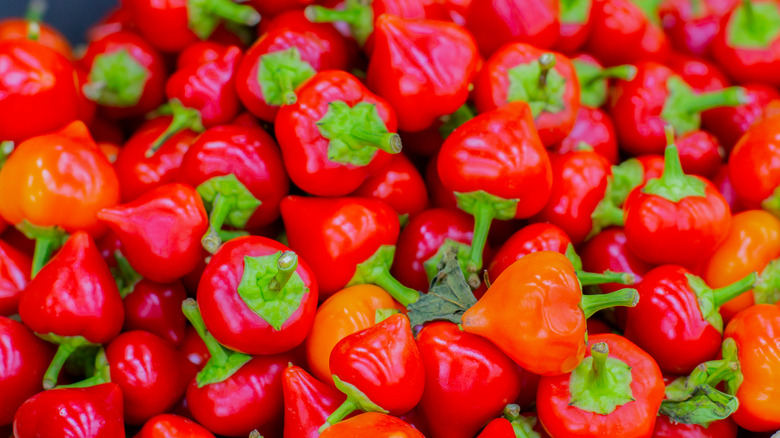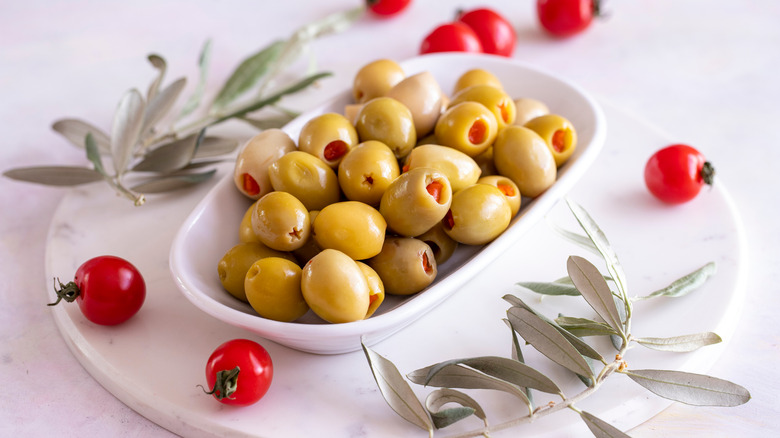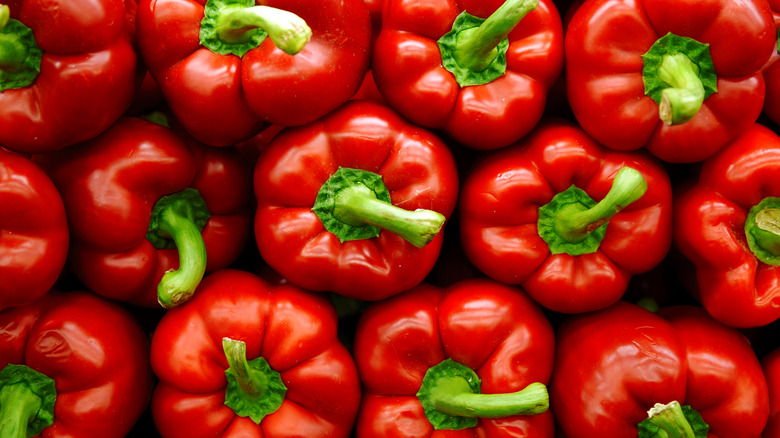Bell Peppers Vs Pimentos: What's The Difference?
Peppers are one of the fundamental building blocks of numerous cuisines, but it should be pretty obvious that not all peppers are the same. It would be difficult to confuse any of the various types of Thai chilis for habaneros, either in taste or visual appearance. Even green, red, and yellow bell peppers all have different flavor profiles. But pimentos and red bell peppers look pretty similar, and they're the same color, so is one just a subcategory of the other?
Nope! The two are different, although they share some similar flavor profiles. Ultimately, while both are sweet relative to many other peppers, pimentos are the smaller, sweeter, and more aromatic of the two — and they're also slightly hotter. Their skin also tends to be thicker and juicier than bell peppers, making them a great choice in any mixture, but less ideal as a filled vessel. The general rule is that bell peppers are great for being stuffed, while pimentos are great as part of the stuffing.
All about pimento peppers
Pimentos are smaller than bell peppers, heart-shaped, and either red or reddish-yellow. They're known for their mildness as well as their sweetness, with one of the lowest Scoville ratings of any pepper. They usually come jarred, although you'll sometimes find them fresh at grocery stores or farmer's markets. When they're available fresh, they're also sometimes called "cherry peppers" — although this can get a bit confusing, as the term "cherry pepper" also refers to a different, hotter type of pepper.
They're a pretty versatile ingredient, but they also have some well-known, iconic uses. Pimento-stuffed green olives are the classic accompaniment to a martini, while pimento cheese is a spread sometimes referred to the "caviar of the south" or "Carolina caviar" for its association with southern culture — it's traditional to eat pimento cheese sandwiches at golf's Masters Tournament. All of these are examples of pickled pimentos, although you can generally use pickled bell peppers in the same recipes without ruining them.
All about red bell peppers
Red bell peppers, meanwhile, are much more ubiquitous; it would be difficult to list the dishes in which they appear because there are just so many. They're a bit larger than pimentos, with that familiar blocky bell pepper shape often capable of standing up unaided. They're considered the sweetest of the three main bell pepper colors, more so than their yellow and especially green cousins (although pimentos are still sweeter). But while pimentos clock in at 100 to 500 Scovilles, red bell peppers are even lower, sitting at a flat 0. This makes pimentos slightly hotter, although a Scoville difference of a few hundred units is very little on a scale which ascends into the millions.
The flavor profiles of these two peppers are generally regarded as similar enough that the two can be swapped for each other without compromising the dish in question. But while you should feel free to swap these two members of the Capsicum annuum family, know that it does make at least a slight taste difference. If you really want that sweet, aromatic flavor, reach for the pimento, but otherwise, a red bell will still serve you fine.


